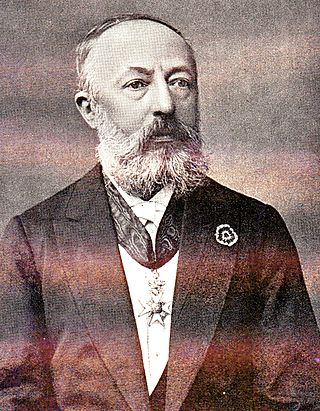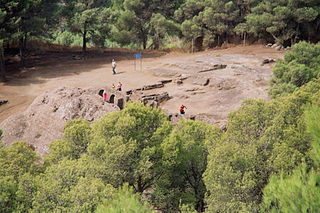The Abbadid dynasty or Abbadids was an Arab dynasty from the tribe of Banu Lakhm of al-Hirah, which ruled the Taifa of Seville in al-Andalus following the downfall of the Caliphate of Cordoba in 1031. After the collapse, they were the most powerful Taifa and before long absorbed most of the others. Abbadid rule lasted from about 1023 until 1091, but during the short period of its existence it exhibited singular energy and typified its time.
Ṭāriq ibn Ziyād, also known simply as Tarik in English, was an Umayyad commander who initiated the Muslim conquest of Visigothic Hispania in 711–718 AD. He led an army and crossed the Strait of Gibraltar from the North African coast, consolidating his troops at what is today known as the Rock of Gibraltar. The name "Gibraltar" is the Spanish derivation of the Arabic name Jabal Ṭāriq, meaning "mountain of Ṭāriq", which is named after him.
Aḥmad ibn Muḥammad al-Maqqarī al-Tilmisānī, (1577-1632) was an Algerian scholar, biographer and historian who is best known for his Nafh at-Tib ,S a compendium of the history of Al-Andalus which provided a basis for the scholarly research on the subject until the twentieth century.

Michael Jan de Goeje was a Dutch orientalist focusing on Arabia and Islam.

Abū Yūsuf Yaʿqūb ibn Yūsuf ibn Abd al-Muʾmin al-Manṣūr, commonly known as Yaqub al-Mansur or Moulay Yacoub, was the third Almohad Caliph. Succeeding his father, al-Mansur reigned from 1184 to 1199. His reign was distinguished by the flourishing of trade, architecture, philosophy and the sciences, as well as by victorious military campaigns in which he was successful in repelling the tide of the Reconquista in the Iberian Peninsula.
ʿAbd al-Wāḥid ibn ʿAlī al-Tamīmī al-Marrākushī was a Moroccan historian who lived during the Almohad period.

Umar ibn Hafsun ibn Ja'far ibn Salim, known in Spanish history as Omar ben Hafsun, was a 9th-century political and military leader who contested Umayyad power in Iberia.
Abū al-ʽAbbās Aḥmad ibn Muḥammad ibn ʽIḏārī al-Marrākushī was a Maghrebi historian of the late-13th/early-14th century, and author of the famous Al-Bayan al-Mughrib, an important medieval history of the Maghreb and Al-Andalus written in 1312.
Kitāb al-bayān al-mughrib fī ākhbār mulūk al-andalus wa'l-maghrib by Ibn Idhāri of Marrakech in the Maghreb ; an important medieval Arabic history of the Maghreb and Iberia, written at Marrakech ca. 1312 / 712 AH. Generally known by its shorter title al-Bayān al-Mughrib, or even just as the Bayān, it is valued by modern researchers as a unique source of information, and for its preservation of excerpts from lost works.
The Banu Ifran or Ifranids, were a Zenata Berber tribe prominent in the history of pre-Islamic and early Islamic North Africa. In the 8th century, they established a kingdom in the central Maghreb, with Tlemcen as its capital.
Al-Qasim al-Ma'mun ibn Hammud was an Arab Caliph of Córdoba in Muslim Spain for two periods, 1018 to 1021, and again for a short time in 1023 until he was driven from the city. He hailed from the Banu Khazraj tribe. He was the brother of the deposed Ali ibn Hammud al-Nasir. His reign was described in Ibn al-Khatib's A'mal al-a'lam.

Abu Ali al-Hassan al-Marrakushi was a Magreb astronomer and mathematician from the Kingdom of Morocco. He was especially important in the field of trigonometry and practical astronomy. He wrote Jāmiʿ al-mabādiʾ wa’l-ghāyāt fī ʿilm al-mīqāt, a treatise on spherical astronomy and astronomical instruments. The first part was translated into French by the orientalist and astronomer Jean Jacques Emmanuel Sédillot during the early 19th century, and published after Sédillot's death.

Abu Ya`qub Yusuf or Yusuf I was the second Almohad Amir or caliph. He reigned from 1163 until 1184 in Marrakesh. He was responsible for the construction of the Giralda in Seville, which was part of a new grand mosque. He was a keen student of philosophy and patron of Averroes.

Martijn Theodoor Houtsma, often referred to as M. Th. Houtsma, was a Dutch orientalist and professor at the University of Utrecht. He was a fellow of the Royal Netherlands Academy of Arts and Sciences, and a leading expert on the history of the Seljuks. He remains best known for his work as editor of the first edition (1913–38) of the standard encyclopedic reference work on Islam, the Encyclopaedia of Islam.

Charles Pellat was a French Algerian academic, historian, translator, and scholar of Oriental studies, specialized in Arab studies and Islamic studies. He was an editor of the Encyclopaedia of Islam published by Brill Academic Publishers, and a member of the Académie des Inscriptions et Belles-Lettres.

The toponym al-Andalus (الأندلس) is first attested in inscriptions on coins minted by the Umayyad rulers of Iberia, from ca. 715.
The literature of al-Andalus, also known as Andalusi literature, was produced in al-Andalus, or Islamic Iberia, from the Muslim conquest in 711 to either the Catholic conquest of Granada in 1492 or the expulsion of the Moors ending in 1614. Andalusi literature was written primarily in Arabic, but also in Hebrew, Latin, and Romance.
The Battle of Sétif took place on April 27, 1153, AD, in the region of Sétif. it was a battle between a coalition of Banu Riyah tribes and the Almohad Caliphate led by the caliph Abd al-Mu'min. The result of the battle was a victory for the Almohads.
The siege of Toledo was launched by the Córdoban caliph, Abdulrahman III, against the rebellious city of Toledo in May 930. The siege lasted for two years and finally fell to the Caliph in June 932.









